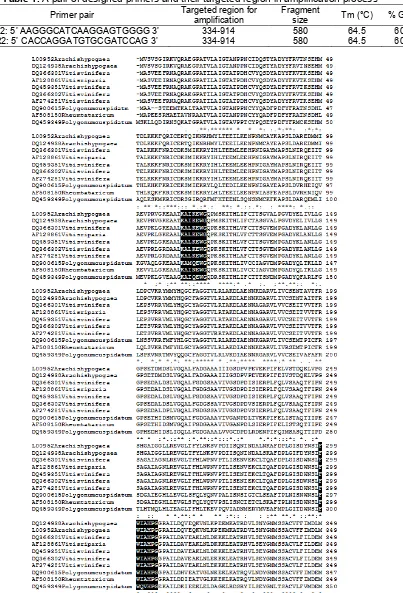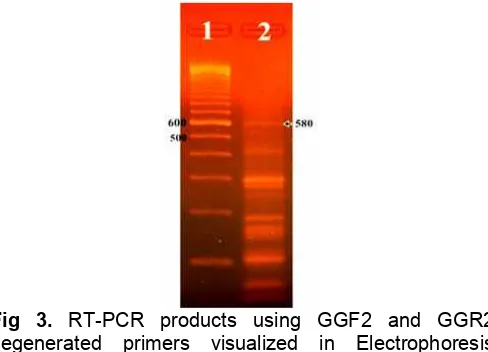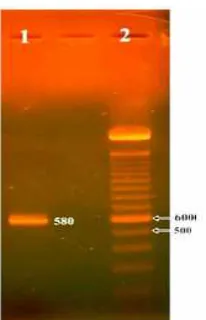CHARACTERIZATION OF 0.58 kb DNA STILBENE SYNTHASE ENCODING GENE
FRAGMENT FROM MELINJO PLANT (
Gnetum gnemon
)
Tri Joko Raharjo
1,*, Rosyida Azis Rizki
1, Stalis Norma Ethica
2,
Elly Rustanti
1, and L. Hartanto Nugroho
31
Department of Chemistry, Faculty of Mathematics and Natural Sciences, Universitas Gadjah Mada, Yogyakarta, Jl. Sekip Utara, Yogyakarta
2
Biotechnology Study Program, Universitas Gadjah Mada, Jalan Teknika Utara, Yogyakarta 3
Biology Department, Universitas Gadjah Mada, JalanSekip Utara, Yogyakarta
Received August 17, 2011; Accepted October 31, 2011
ABSTRACT
Resveratrol is a potent anticancer agent resulted as the main product of enzymatic reaction between common precursor in plants and Stilbene Synthase enzyme, which is expressed by sts gene. Characterization of internal fragment of Stilbene Synthase (STS) encoding gene from melinjo plant (Gnetum gnemon L.) has been carried out as part of a larger work to obtain a full length of Stilbene Synthase encoding gene of the plant. RT-PCR (Reverse Transcriptase Polymerase Chain Reaction) was performed using two degenerated primers to amplify the gene fragment. Ten published STS conserved amino acid sequences from various plant species from genebank were utilized to construct a pair of GGF2 (5' GTTCCACCTGCGAAGCAGCC 3') and GGR2 (5' CTGGATCGCACATCC TGGTG 3') primers. Both designed primers were predicted to be in the position of 334-354 and 897-916 kb of the gene respectively. Total RNA isolated from melinjo leaves was used as template for the RT-PCR amplification process using two-step technique. A collection of 0.58 DNA fragments was generated from RT-PCR amplification and met the expected results. The obtained DNA fragments were subsequently isolated, refined and sequenced. A nucleotide sequence analysis was accomplished by comparing it to the existed sts genes available in genebank. Homology analysis of the DNA fragments with Arachis hypogaea L00952 sts gene showed high similarity level. Taken together, the results are evidence that the amplified fragment obtained in this study is part of melinjo sts gene
Keywords:Resveratrol, stilbene synthase gene (sts), RT-PCR, Gnetum gnemon L.
INTRODUCTION
Resveratrol is a class of stilbenoid that shows great effectiveness as anticancer agents in several most prevalent cancers such as servix cancer [1], pancreatic cancer [2], gastrous cancer [3], and liver cancer [4]. It is a natural polyphenol and an antioxidant, which is part of plant’s secondary metabolites. The compound is synthesized by a specific group of plants including Vitis vinifera [5], Arachis hypogaea [6-7], Gnetum gnemon and Pinus strobes due to several factors including stress, pathogen attack, UV radiation or wound.
Resveratrol with an IUPAC name of (E)-5-(4-hydroxystyryl)benzene-1,3-diol [8] has a relatively low molecular weight [9]. In room temperature, the physical appearance of the compound is white powder. The Isolation process of resveratrol compound usually is carried out from tissues of resveratrol producing plant. After a certain methanol treatment and undergoing chloroform extraction method, impure resveratrol can be obtained as yellowish powder from melinjo’s bark. Once the impure mixture is separated using LVC (liquid vacuum chromatograph) technique, pure resveratrol can
be resulted. UV spectroscopy UV-VIS, IR spectrophotometer and NMR spectrometer NMR are the common methods used to identify resveratrol. However, those direct isolation techniques normally result in only very low amount of resveratrol.
In plants, resveratrol biosynthesis is highly controlled by the action of STS enzyme [10]. STS enzyme is extremely responsible to the formation of resveratrol’s backbond structure from common precursors. Therefore, STS encoding gene has been the target of investigation as high production of STS enzyme will likely increase the production of resveratrol. Genetic modification to accelerate the production of STS enzyme has been intensively investigated [11]. The initial part of such works is the characterization of STS encoding gene from specific resveratrol producing plants.
modified plants are able to produce STS enzyme that induce high production of resveratrol [15].
Among resveratrol producing plants, melinjo shows a convincing ability to produce resveratrol due to the presence of numerous derivatives of resveratrol found in the plant’s tissues [16]. However, due to limited information about sts gene in melinjo, its potential for genetic modification has not been explored.
This study is aimed to obtain information about the STS cDNA of melinjo as the main ingredient in STS gene over expression works. The initial characterization of the full length of melinjo STS resulted only 0.40 kb fragment [17] of more than 1.00 kb of nucleotides expected for a full length of plants’ sts genes in average. For that reason, further characterization of Stilbene Synthase encoding gene fragment from melinjo (Gnetum gnemon) needs to be done.
This study reports new 0.58 kb characterized sts gene fragment of melinjo plant. The fragment is proven to be part of the full length of melinjo STS gene aside of the 0.40 one from previous study. The new sts gene nucleotide sequence shares high similarity with sts genes.
EXPERIMENTAL SECTION
Materials
Materials used for this study were leaf tissues of melinjo plant, Genebank database of amino acid and nucleotide sts gene sequences of various plants (http://www.ncbi.nlm.nih.gov). Trizol reagent (Invitrogen), isoprophanol (Merck), chloroform (Merck), ethanol 75% (Merck), RNAse free water (Gibco TM), liquid nitrogen, transcriptor first strandcDNA synthesis kit (Roche) [oligo (dT) primer, random hexamer primer, transcriptor RT-reaction buffer 5X, protector RNAse inhibitor, deoxynucleotide mix (dNTP), transcriptor RT], illustraTM Ready To Go PCR bead (GE Healthcare), PureLinkTM Quick Gel Extraction Kit (Invitrogen) [gel solubilization buffer (L3), wash buffer (W1), elution buffer (E5), quick gel extraction column, wash tubes, and recovery tubes], agarose (Invitrogen), loading buffer (Invitrogen), TAE buffer, ethidium bromide (EB) (Invitrogen), DNA marker (Invitrogen), tris base (Merck), acetic acid glacial (Merck), EDTA (Merck) pH 8, dH2O (Merck), sterile aquadest (LPPT).
Instrumentation
The apparatus used in this work were Denver AA-250 digital balance, Hiramaya HL 36 AE autoclave, OSK Seiwa Reiko water bath incubator, Sorvall Biofuge centrifugator, Nuaire laminar flow, Barnstead vortex, Bio Rad Thermal cycler PCR, Gilson micro pipettes, Sanyo
microwave, Bio Rad (Wide Minisub(R) cell GT) electrophoresis, Shimadzu Probe UV-Vis Spectrophotometer, Bio-Rad UV lamp, ABI PRISM 310DNA sequencer.
Procedure
A pair of primers used to amplify the sts gene fragment was designed based on conserved regions of sts genes from other plants that have already been
published in the genebank site
(http://www.ncbi.nlm.nih.gov). Ten amino acid sequences of sts genes used in primer designing stage areArachis hypogaea (Access Number NCBI: L00952 and DQ124938) Vitis vinifera (DQ459351, AF274281, DQ366302 DQ366301) Vitis riparia (AF128861), Polygonum cuspidatum (DQ900615 and DQ459349) Rheum tataricum (AF508150). Clustalw software (http://www.ebi.ac.uk/Tools/msa/clustalw2/) was used in the primer designing process to check the homology of amino acid sequences of Stilbene Synthase protein available in the genebank. Conserved amino acid regions were back translated to obtain conserved amino acid by considering melinjo preference codon. The designed primers were then chosen based on generally accepted primer parameters: GC content of 45-55%, primer length of 18-22 pb and with zero possibility to form hairpin structures. Fragment target length of 500-700 pb was set based on primers relative positions to sts gene ofArachis hypogaea. The defined primers were then synthesized at 1stBASE (Singapore) to become ready for use.
The initial work of melinjo sts gene fragment characterization was the isolation of total RNA from melinjo leaf tissues using Trizol reagent and liquid nitrogen according to reagent’s protocol. The next part was running RT-PCR using mRNA molecules available in the obtained total RNA as template. Gel isolation was conducted to isolate single band that refers to 0.58 kb fragment. DNA fragment sequencing, analysis to the resulted DNA sequence and homology analysis were performed to check whether the obtained fragment was truly part of melinjo sts gene. If homology test results in not less than 60% similarity level to any sts gene sequence available in genebank, then the fragment is strongly believed to be part of sts gene.
RESULT AND DISCUSSION
Table 1.A pair of designed primers and their targeted region in amplification process
No Primer pair Targeted region foramplification Fragmentsize Tm (°C) % GC
1 GGF2: 5’ AAGGGCATCAAGGAGTGGGG 3’ 334-914 580 64.5 60 2 GGR2: 5’ CACCAGGATGTGCGATCCAG 3’ 334-914 580 64.5 60
Fig 2. Total RNA visualized in electrophoresis agarose Gel (1) 1.12μg, (2) 3.36 μg, and (3) 5.60μg Total RNA of melinjo leaves
Fig 3. RT-PCR products using GGF2 and GGR2 degenerated primers visualized in Electrophoresis Agarose Gel (2), DNA marker (1) (scales in bp)
similarity level was much higher than that from nucleotide sequences. Among several conserved regions available in the amino acids sequences of sts gene, two regions located in the position of 112-118 = KAIKEWG, 299-305 = LDRTSWC, were selected and modified to generate GGF2 and GGR2 primers used to amplify melinjo sts gene. The length of ideal oligonucleotide used as primers generally contains 20-30 nucleotides and 50-60% G+C. Our primers complied with the rule. The designed primers GGF2 and GGR2 and their properties are shown in Table 1.
Total RNA was isolated from young leaf tissues of melinjo relied on previous researches on Vitis vinifera proving that the highest sts gene expression is in the plant’s leaves. The aim of total RNA isolation is to obtain an adequate amount of Stilbene Synthase mRNAs to be used as templates for reverse transcription-polymerase chain reaction (RT-PCR).
Around 0.25 mg/mg fresh weight tissue of total RNA was recovered using Trizol kit (Invitrogen) according to written protocol of the reagent’s manufacturer. Trizol kit isolation has similar principle to common phenol-chloroform isolation. The obtained
melinjo total RNA was then diluted in RNasefree water for storage and ready for further step. The quality of the result was checked both qualitatively and quantitatively. Qualitative assay to the obtained total RNA was done using gel electrophoresis technique with 1% agarose gel in TAE solution. Melinjo total RNA obtained using electrophoresis technique was photographed and showed in Fig. 2.
Quantitative assay to the isolated total RNA was performed based on absorbance measurement using UV spectrophotometer at 254 nm. Total RNA isolate was diluted by dissolving 5 μL of it in 995 μL sterile aquadest. Solution absorbance was measured using
UV spectrophotometer at two different wavelengths: λ 260 and λ 280 wait sterile aquadest as blank solution. The R260/280 ratio of obtained total RNA isolate was 1.75, which was higher than the expected value (below 1.60) showing there were contaminations from protein and other organic compound in the result.
RT-PCR process in two steps was carried out using mRNAs contained in total RNA as templates. The first step involves single chain synthesis of cDNA (reverse transcription, RT stage). The second step is common PCR stage. RT step was conducted using Transcriptor First Strand cDNA Synthesis Kit (Roche). Reaction mixture was made from 5.4 μL total RNA (template), 1μL oligo-dT primer, 2μL random hexamer primer and 4.6 μL RNase free water to obtain a total volume of 13 μL. 20 μL mineral oil was added to the mixture and followed by short centrifugation (spin) for 10 sec. The template-primer mixture was heated in PCR machine at 65 °C for 10 min and then cooled in an ice bath. 4μL transcriptor RT reaction buffer 5X was added to the template-primer mixture along with 2 μL dNTP 0.5 μL protector RNAse inhibitor and 0.5 μL transcriptor RT to obtain a final total volume of 20 μL. The mixture was carefully homogenized and spinned for 10 sec. Final reaction mixture was incubated at 25 °C for 10 min, heated in PCR machine at 55 °C for 30 min and then at 85 °C for 5 min.
Fig 4. Gel isolated product of RT-PCR fragment using GGF2 and GGR2 primers (2), DNA marker (1) (scales in bp)
Fig 5. Nucleotide sequence of DNA fragment obtained from RT-PCR using GGF2 primer from the reading of sequencing process’ result
process had completely finished.
RT-PCR amplification result was identified using electrophoresis technique, which is similar to that for total RNA qualitative assay in buffer TAE 1X at 100 V for 40 min but using 1.5% agarose gel. Visualization was done using UV light at 254 nm and photographed using digital camera and the result is shown in Fig. 3.
Since the visualization of the electrophoresis RT-PCR results shown in Fig. 3 did not show a single band, and then gel isolation was carried out to get the targeted sts DNA fragment of melinjo. Fragment isolation was done by cutting out targeted band that was available along with other PCR products seen in the agarose gel. Using PureLink™ Quick Gel Extraction kit (Invitrogen) the targeted fragment DNA can be obtained in a recovery tube. Further qualitative analysis to isolated DNA from gel was carried out using electrophoresis with 1.5% agarose gel at 50 volt in 90 min shown a single DNA band (Fig. 4).
Quantitative analysis to the targeted DNA isolated from gel was carried out using UV spectrophotometer by diluting 5 μL isolate in 995μL aquadest and measuring the solution’s absorbance with aquadest as blanko at
two different wavelengths of λ 260 and λ 280.
Absorbance ratio (R260/280) was calculated to determine the purity of DNA fragments obtained. Sequencing process to DNA fragments using primers of GGF2 and GGR2 was carried out using ABI PRISM 310 sequencer and was conducted by first BASE at Singapore.
Based on the reading sequencing results, the nucleotide sequence of sts gene fragment of melinjo obtained in our work is shown in Fig. 5.
The characterization of nucleotide sequences obtained from sequencing analysis to fragment resulted from RT-PCR process includes homology test of it with sts gene of Arachis hypogaea (access code: L00952) using CLUSTAL 2.0.12 software of multiple sequence alignment. Sequence alignment is part of homology analysis to the obtained 0.58 kb sequence to make sure that the RT-PCR product is truly part of melinjo sts gene. The alignment result between the obtained DNA fragment and Arachis hypogaea sts gene is shown in Fig. 6.
Result from the reading of sequencing process’ result was 270 bp nucleotide sequence of RT-PCR product. In such alignment reading, the star signs showed similar amino acid in all fragments used in alignment process. Alignment of the obtained DNA fragment in our work with sts gene from Arachis hypogaea showed similarity. From that result, we can conclude that our DNA fragment is truly part of melinjo sts gene and the sequence obtained from sequencing process is also truly part of sts gene sequence.
CONCLUSION
This study demonstrates the isolation of a DNA fragment as part of melinjo sts gene that encodes the synthesis of Stilbene Synthase enzyme. The enzyme plays the key role in resveratrol biosynthetic pathway of melinjo. Based on the homology analysis on the obtained nucleic acid sequence with the existed sts genes in genebank, we make conclusion that the sts DNA fragment we obtained was part of sts gene that encodes melinjo Stilbene Synthase as evidenced by their high similarity to other plant stilbene synthase genes. To characterize the full length of melinjo sts gene, further work is ongoing.
ACKNOWLEDGEMENT
The authors would like to thank the General Director of Higher Education, Republic of Indonesia for funding this research through Competency Competitive Grant Contract Number 374/SP2H/PP/DP2M/VI/2010.
REFERENCES
1. Opipari, A.W., Tan, L., Boitano, A.E., Sorenson, D.R., Aurora, A., and Liu, J.R., 2004,Cancer Res., 64, 2, 696–703.
2. Ding, X.Z., and Adrian, T.E., 2002, Pancreas, 25, 4, 71–76.
3. Holian, O., Wahid, S., Atten, M.J., and Attar, B.M., 2002,Am. J. Physiol., 282, 5, 809–816.
4. Kozuki, Y., Miura, Y., and Yagasaki, K., 2001, Cancer Lett., 167, 2, 151–156.
5. Wang, W., Tang, K., Yang, H-R., Wen, P-F., Zhang, P., Wang, H-L., and Huang, W-D., 2010, Plant Physiol. Biochem., 48, 2-3, 142–152.
6. Chen, R.S., Wu, P.L., and Chiou, R.Y., 2002, Peanut Roots As A Source of Resveratrol,J. Agric. Food Chem., 50, 6, 1665–1667.
7. Chung, I-M., Park, M.R., Chun, J.C., and Yun S.J., 2003,Plant Sci., 164, 1, 103–109.
8. Leiro, J., Ezequiel, A., Juan A., Reyes, L., Eugenio, U., and Francisco, O., 2004,J. Leukocyte Biol., 75, 6, 1156–1165.
9. Deak, M., and Falk, H., 2003, Monatsh. Chem., 134, 6, 883–888.
10. Gorham, J., 1995, The Biochemistry of The Stilbenoids, Chapman & Hall, London.
11. Halls, C., and Yu, O., 2008,Trends Biotechnol.,26, 2, 77–81.
12. Richter, H., Pezet, R., Viret, O., and Gindro, K., 2006,Physiol. Mol. Plant Pathol., 67, 3-5, 248–26 13. Raiber, S., Schröder, G., and Schröder, J., 1995,
14. Shin, S-Y., Han, N.S., Park, Y-C., Kim, M-D., and Seo, J-H., 2011, Enzyme Microb. Technol., 48, 1, 48–53.
15. White, E., 2009,Basic Biotechnol., 5, 1, 84–90. 16. Illiya, I., Ali Z., Tanaka, T., Iinuma, M., Furusawa, M.,
Nakaya, K., Murata, J., Darnaedi, D., Matsuura, N.,
and Ubukata, M., 2003, Phytochemistry, 62, 4, 601–606.


